PIB Headquarters
Minimum Support Prices: From Safety Net to Self-Sufficiency
Stronger Procurement, Wider Farmer Coverage, Digital Reforms, and Advancement of National Self-Reliance
प्रविष्टि तिथि:
10 OCT 2025 12:25PM by PIB Delhi
- MSP for Rabi Marketing Season (RMS) 2026–27 has been approved; procurement estimated at 297 Lakh MT, and farmers to receive about ₹84,263 crore at MSP.
- For RMS 2026–27, margins over cost of production peak at 109% for wheat
- MSP payouts of foodgrains more than tripled from ₹1.06 lakh crore (2014-15) to ₹3.33 lakh crore (July 2024–June 2025), procurement increased from 761.40 LMT to 1,175 LMT over same period, benefitting 1.84 crore farmers
- For self-sufficiency in pulses, 100% production of tur (arhar), urad, masoor to be procured up to 2028–29; with 2.46 LMT tur already procured by March, 2025.
|
Introduction
Each cropping season, India’s farmers work tirelessly in their fields – but uncertainties in weather and markets can wipe out their gains. Unseasonal rains, droughts, or floods can destroy months of hard work in a matter of days. Even when crops are harvested successfully, volatile market prices can push farmers into distress sales, forcing them to sell at rates far below the cost of production. For small and marginal farmers, who depend entirely on agriculture for their livelihood, these risks can mean spiralling debts, loss of income, and even abandonment of farming altogether.
This is where the Minimum Support Price (MSP) becomes a lifeline. Minimum Support Price (MSP) is a crucial mechanism through which the government supports farmers by purchasing their crops at a pre-determined price. For example, a wheat grower can be assured of ₹2,585 per quintal for his crop (MSP for 2026‑27), even if open-market prices dip. Similarly, a paddy farmer can sell to government agencies at ₹2,369/quintal (MSP for 2025‑26) for common paddy. This assured price encourages farmers to invest in quality seeds and technology without fear of distress sales.
MSP Policy and Determination
Annually, Government announces Minimum Support Prices (MSPs) for 22 mandated agricultural crops based on the recommendations of the Commission for Agricultural Costs & Prices (CACP), after considering the views of the concerned State Governments and Central Ministries/Departments. In addition, MSP for Toria and de-husked coconut is also fixed on the basis of MSPs of rapeseed & mustard, and copra, respectively.
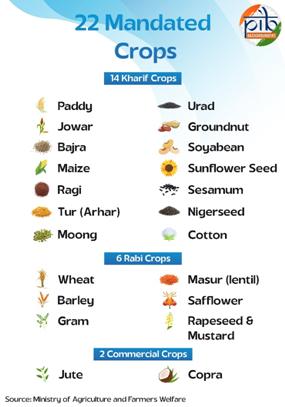
While recommending MSP, CACP considers important factors, i.e., cost of production, overall demand-supply situations of various crops in domestic and world markets, domestic and international prices, inter-crop price parity, terms of trade between agriculture and non-agriculture sector, likely effect of price policy on rest of economy and a minimum of 50 per cent as the margin over the cost of production.
Further, the production cost computed by CACP includes all paid out costs such as those incurred on account of hired human labour, bullock labour/machine labour, rent paid for leased land, expenses incurred on use of material inputs like seeds, fertilizers, manures, irrigation charges, depreciation on implements and farm buildings, interest on working capital, diesel/electricity for operation of pump sets etc, miscellaneous expenses and imputed value of family labour. The cost formula used for calculating MSP is uniform for all 22 mandated crops and states. Notably, this calculation includes considerations such as family labour, acknowledging the collective efforts of entire farming households rather than solely focusing on individual farmers.
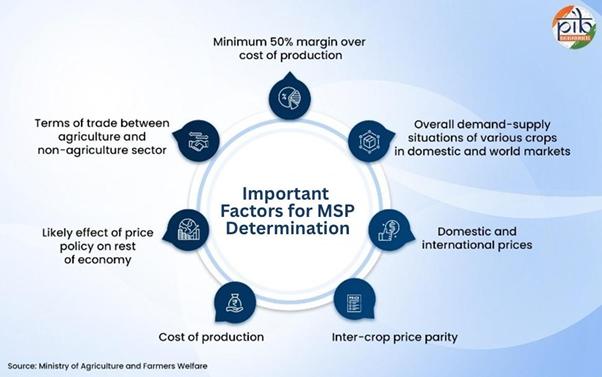
Since 2018-19, Government has been increasing MSPs for all mandated crops in line with the Union Budget 2018-19 announcement for setting up MSP at least 1.5 times the cost of production. This ensures a minimum return of 50% over the all-India weighted average cost of production for all crops.
Data on MSP: Rabi Marketing Season 2026-27 and Kharif Marketing Season 2025-26
The Cabinet has approved the increase in the Minimum Support Prices (MSP) for all mandated Rabi Crops for Marketing Season 2026-27 on 1st October 2025. Further, the government has increased the MSP of mandated Crops for Kharif Marketing Season 2025-26 to ensure remunerative prices to the growers for their produce.
|
RABI CROPS
|
|
S.N.
|
Crops
|
MSP 2026-27 (₹/quintal)
|
Cost of Production 2026-27 (₹/quintal)
|
Margin Over Cost (%)
|
MSP 2025-26 (₹/quintal)
|
Increase in MSP (Absolute)
|
|
1
|
Wheat
|
2,585
|
1,239
|
109%
|
2,425
|
160
|
|
2
|
Barley
|
2,150
|
1,361
|
58%
|
1,980
|
170
|
|
3
|
Gram
|
5,875
|
3,699
|
59%
|
5,650
|
225
|
|
4
|
Lentil (Masur)
|
7,000
|
3,705
|
89%
|
6,700
|
300
|
|
5
|
Rapeseed & Mustard
|
6,200
|
3,210
|
93%
|
5,950
|
250
|
|
6
|
Safflower
|
6,540
|
4,360
|
50%
|
5,940
|
600
|
|
S.N.
|
Crops
|
MSP 2025-26 (₹/quintal)
|
Cost of Production 2025-26 (₹/quintal)
|
Margin Over Cost (%)
|
MSP 2024-25 (₹/quintal)
|
Increase in MSP (Absolute)
|
|
KHARIF CROPS
|
|
1
|
Paddy
|
Common
|
2,369
|
1,579
|
50%
|
2,300
|
69
|
|
Grade A
|
2,389
|
---
|
---
|
2,320
|
69
|
|
2
|
Jowar
|
Hybrid
|
3,699
|
2,466
|
50%
|
3,371
|
328
|
|
Maldandi
|
3,749
|
---
|
---
|
3,421
|
328
|
|
3
|
Bajra
|
2,775
|
1,703
|
63%
|
2,625
|
150
|
|
4
|
Ragi
|
4,886
|
3,257
|
50%
|
4,290
|
596
|
|
5
|
Maize
|
2,400
|
1,508
|
59%
|
2,225
|
175
|
|
6
|
Tur/Arhar
|
8,000
|
5,038
|
59%
|
7,550
|
450
|
|
7
|
Moong
|
8,768
|
5,845
|
50%
|
8,682
|
86
|
|
8
|
Urad
|
7,800
|
5,114
|
53%
|
7,400
|
400
|
|
9
|
Groundnut
|
7,263
|
4,842
|
50%
|
6,783
|
480
|
|
10
|
Sunflower seed
|
7,721
|
5,147
|
50%
|
7,280
|
441
|
|
11
|
Soyabean (Yellow)
|
5,328
|
3,552
|
50%
|
4,892
|
436
|
|
12
|
Sesamum
|
9,846
|
6,564
|
50%
|
9,267
|
579
|
|
13
|
Nigerseed
|
9,537
|
6,358
|
50%
|
8,717
|
820
|
|
14
|
Cotton
|
Medium Staple
|
7,710
|
5,140
|
50%
|
7,121
|
589
|
|
Long Staple
|
8,110
|
---
|
---
|
7,521
|
589
|
|
COMMERCIAL CROPS
|
|
1
|
Jute
|
5,650
|
3,387
|
67%
|
5,335
|
315
|
|
S.N.
|
Crops
|
MSP 2025 (₹/quintal)
|
Cost of Production 2025 (₹/quintal)
|
Margin Over Cost (%)
|
MSP 2024 (₹/quintal)
|
Increase in MSP (Absolute)
|
|
2
|
Copra
|
Milling
|
11,582
|
7,721
|
50%
|
11,160
|
422
|
|
Ball
|
12,100
|
---
|
---
|
12,000
|
100
|
For Kharif crops Marketing Season 2025-26:
The highest absolute increase in MSP over the previous year has been recommended for nigerseed (₹820 per quintal) followed by Ragi (₹596 per quintal), Cotton (₹589 per quintal) and Sesamum (₹579 per quintal).
The margin to farmers over their cost of production are estimated to be highest in case of bajra (63%) followed by maize (59%), tur (59%) and urad (53%). For rest of the crops, margin to farmers over their cost of production is estimated to be at 50%. In the recent years, Government has been promoting the cultivation of crops, other than cereals such as pulses, oilseeds, and Nutri-cereals/ Shree Anna, by offering a higher MSP for these crops.
For Rabi crops Marketing Season 2026-27:
The absolute highest increase in MSP has been announced for Safflower at ₹600 per quintal followed by Lentil (Masur) at ₹300 per quintal. For Rapeseed & Mustard, gram, barley, and wheat, there is an increase of ₹250 per quintal, ₹225 per quintal, ₹170 per quintal and ₹160 per quintal respectively.
The highest expected margin over All-India weighted average cost of production is 109% for wheat, followed by 93% for rapeseed & mustard; 89% for lentil; 59% for gram; 58 percent for barley; and 50% for safflower. This increased MSP of rabi crops ensures remunerative prices to the farmers and incentivise crop diversification.
During RMS 2026–27, procurement is estimated at about 297 Lakh MT, for which farmers are expected to receive approximately ₹84,263 crore at the proposed MSP.
Procurement Mechanisms
The Government's proactive measures have ensured enhanced procurement and timely payments to farmers, ensuring that the benefits of MSP hikes translate into tangible support. Over the years, procurement mechanisms have been strengthened, leading to greater participation by farmers across states and commodities.
Cereals and coarse cereals are procured by the Food Corporation of India (FCI) and designated State Agencies. The procurement estimates for wheat and paddy are finalized by the Government of India in consultation with State Governments and FCI before each marketing season. These estimates are based on factors like estimated production, marketable surplus, and crop patterns.
Pradhan Mantri Annadata Aay Sanrakshan Abhiyan (PM-AASHA)
|
Objective:
PM-AASHA aims to ensure that farmers receive remunerative prices for their produce while making essential commodities available to consumers at affordable rates
Components & Functioning:
One of the key components is the Price Support Scheme (PSS). It is activated when market prices of notified pulses, oilseeds, and copra fall below MSP during peak harvest. Eligible produce meeting Fair Average Quality (FAQ) standards is procured directly from pre-registered farmers possessing valid land records via National Agricultural Cooperative Marketing Federation of India Ltd. (NAFED) and National Cooperative Consumers’ Federation of India Ltd. (NCCF). This eliminates intermediaries and safeguards farmers from distress sales.
Continuity:
During the 15th Finance Commission Cycle, the Government of India has approved the continuation of PM-AASHA scheme up to 2025-26.
|
Pulses, oilseeds, and copra are procured under the Price Support Scheme (PSS) of the umbrella scheme Pradhan Mantri Annadata Aay Sanrakshan Abhiyan (PM-AASHA), in consultation with the concerned State Government. Procurement is triggered when the market price of these crops falls below MSP. The main agencies for procurement under PM-AASHA are the National Agricultural Cooperative Marketing Federation of India Ltd. (NAFED) and the National Co-operative Consumers’ Federation of India Ltd. (NCCF).
Cotton and jute are procured at MSP through the Cotton Corporation of India (CCI) and the Jute Corporation of India (JCI) respectively. There is no maximum limit on the quantity of jute and cotton procured from farmers.
From MSP to Atmanirbharta
India has witnessed significant growth in pulses production. However, Prime Minister Narendra Modi has set an ambitious goal of achieving self-sufficiency in pulses by 2027, thereby eliminating the need for imports. It has been emphasized that with the cooperation of farmers, India will become ‘Atmanirbhar’ in pulses before December 2027.
To achieve this, the Government announced in Budget 2025 that 100% of the state’s production of tur (arhar), urad, and masoor will be procured for four years, up to 2028–29. In line with this commitment, the Government has also enhanced the PM-AASHA guarantee for procurement of pulses at MSP from ₹45,000 crore to ₹60,000 crore.
By 25 March 2025, a total of 2.46 lakh metric tonnes of Tur (Arhar) has been procured from farmers in five states (Andhra Pradesh, Gujarat, Karnataka, Maharashtra and Telangana), benefitting 1,71,569 farmers.
Impact of MSP Procurement
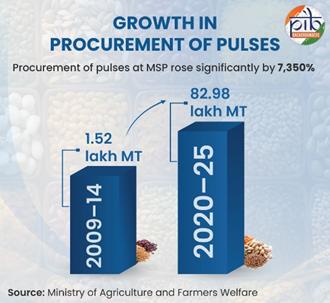
The last eleven years have witnessed a remarkable turnaround in the pulses sector. Once marked by low cultivation, limited procurement, high import dependence, and elevated consumer prices, the sector now reflects higher production, greater procurement at increased MSPs, reduced import reliance, and improved price stability. Procurement of pulses at MSP rose significantly by 7,350%, from 1.52 lakh metric tonnes during 2009–14 to 82.98 lakh metric tonnes during 2020–25.
Similarly, oilseeds procurement at MSP increased by more than 1,500% in the last 11 years, reflecting the government’s strong support for oilseed farmers.
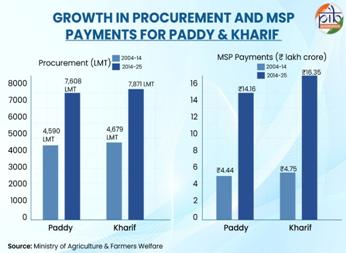
The procurement of paddy has also expanded significantly. Between 2004–14, procurement stood at 4,590 lakh metric tonnes, which rose to 7,608 lakh metric tonnes during 2014–25. For 14 Kharif crops taken together, procurement increased from 4,679 lakh metric tonnes during 2004–14 to 7,871 lakh metric tonnes during 2014–25.
This growth is reflected in the MSP payments made to farmers, which for paddy alone increased from ₹4.44 lakh crore during 2004–14 to ₹14.16 lakh crore during 2014–25. Similarly, for all 14 Kharif crops, MSP payments rose from ₹4.75 lakh crore to ₹16.35 lakh crore over the same periods.
During the Rabi Marketing Season (RMS) 2024-25, the Food Corporation of India (FCI) procured 266 Lakh Metric Tonnes (LMT) of wheat, surpassing previous year’s procurement of 262 LMT and well above the 188 LMT recorded in RMS 2022-23. This achievement has helped secure the nation’s food grain sufficiency.
Over 22 lakh farmers benefitted from the procurement, with about ₹0.61 lakh crore directly credited to their bank accounts as payment for wheat purchased at the Minimum Support Price (MSP).
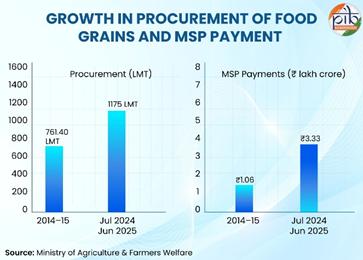
Foodgrains Overall
Overall, procurement of foodgrains has grown steadily, increasing from 761.40 lakh metric tonnes in 2014–15 to 1,175 lakh metric tonnes in 2024-25 (from July to June). This expansion benefitted 1.84 crore farmers. The expenditure incurred on procurement at MSP values more than tripled, rising from ₹1.06 lakh crore to ₹3.33 lakh crore over the same period.
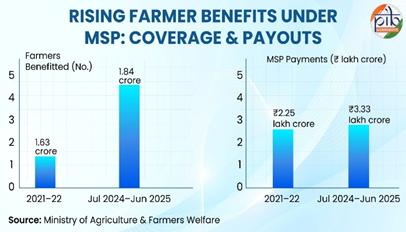
The benefits of enhanced procurement at MSP have directly translated into wider farmer coverage and higher income support. The number of farmers benefitting from MSP procurement increased from 1.63 crore in 2021–22 to 1.84 crore during 2024-25 (from July to June). Over the same period, the MSP value disbursed to farmers rose significantly, from ₹2.25 lakh crore to ₹3.33 lakh crore. This steady rise in both farmer participation and procurement expenditure reflects the government’s commitment to ensuring fair returns to farmers and strengthening their economic security.
Technology and Transparency in MSP Procurement
To improve transparency, efficiency, and ease of operations, the Government has introduced several digital platforms:
- Under Price Support Scheme (PSS):
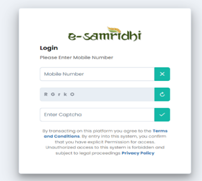
e-Samriddhi (developed by NAFED) and e-Samyukti (developed by NCCF):
Streamline procurement process from farmer registration to final payment. Farmers register online with Aadhaar, land records, bank details, and crop information. Post-registration, farmers willing to offer their stock under the scheme can choose the nearest purchase centre, receive digitally scheduled slots for visit, and get direct MSP payments credited to their bank accounts, thereby eliminating intermediaries and delays.

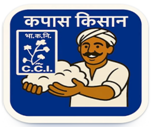
Kapas Kisan App (developed by Cotton Corporation of India, Ministry of Textiles):
Dedicated mobile app for cotton farmers under MSP. It offers self-registration; slot booking; real-time updates on quality assessment, payment processing and accepted quantities; and multilingual support. It reduces paperwork, waiting time, and distress sales while ensuring faster, transparent procurement.
Conclusion
The MSP framework continues to safeguard farmer incomes by assuring at least 50% margin over cost, a principle in place since 2018-19. Over time, this has been reinforced through higher procurement volumes, rising disbursements, and wider farmer coverage. The focus on pulses, oilseeds and nutri-cereals/shri anna, coupled with targeted procurement and digital reforms, is steering Indian agriculture towards greater diversification and reduced import dependence. Together, these measures underline the government’s long-term strategy of using MSP not only as a safety net for farmers but also as a driver of national self-sufficiency in key crops.
References:
Lok Sabha
Rajya Sabha
Ministry of Agriculture and Farmers Welfare
APEDA
PIB Press Releases
PIB Backgrounder
PIB Factsheet
Click here to see pdf
****
SK/SM
(रिलीज़ आईडी: 2177219)
आगंतुक पटल : 6323